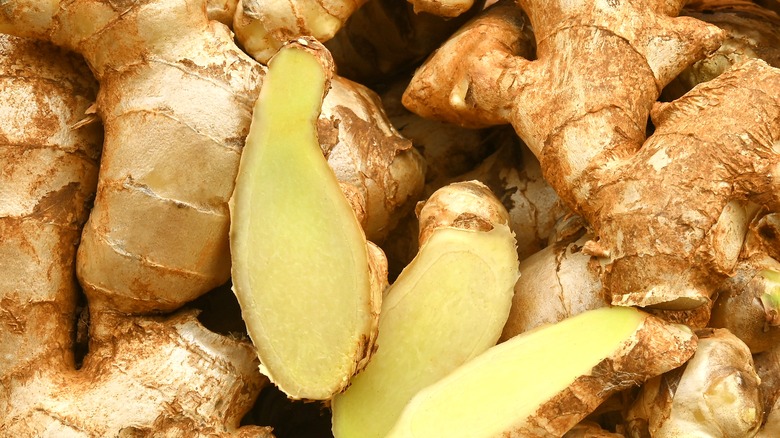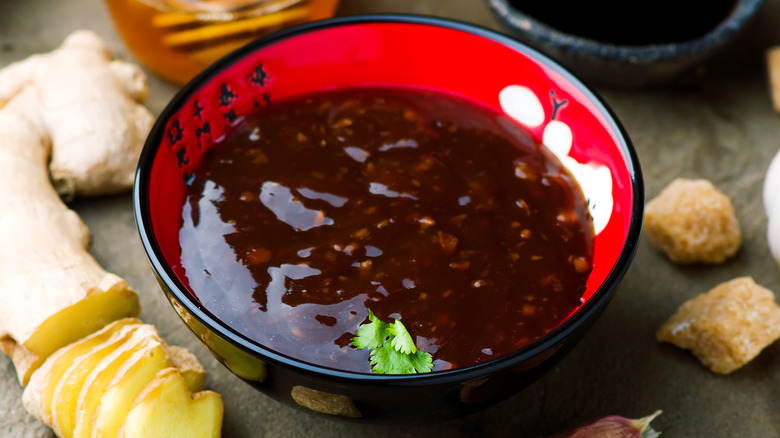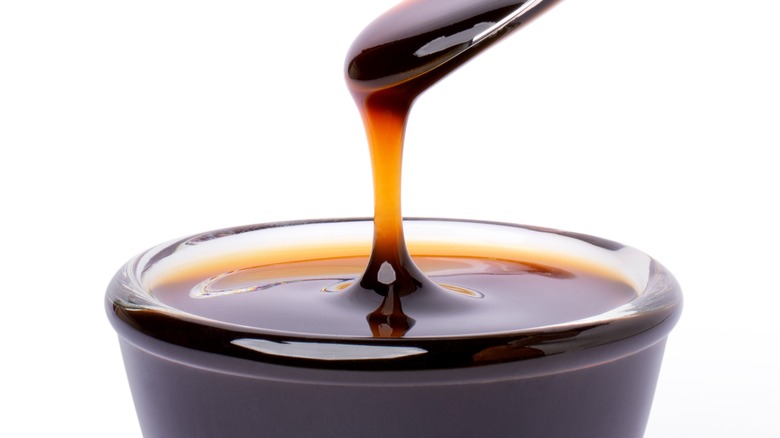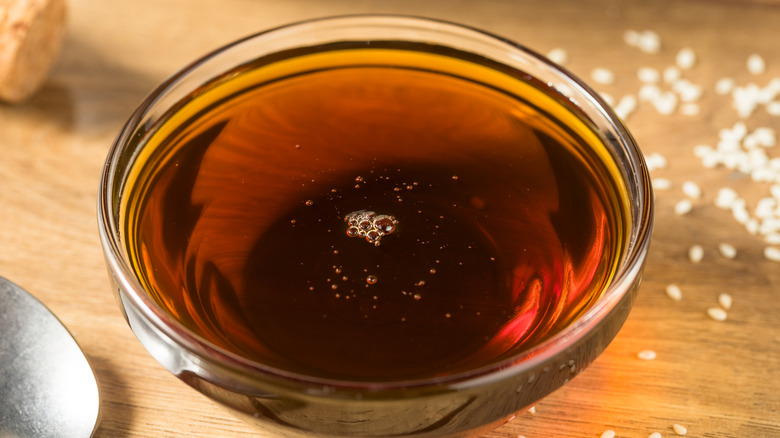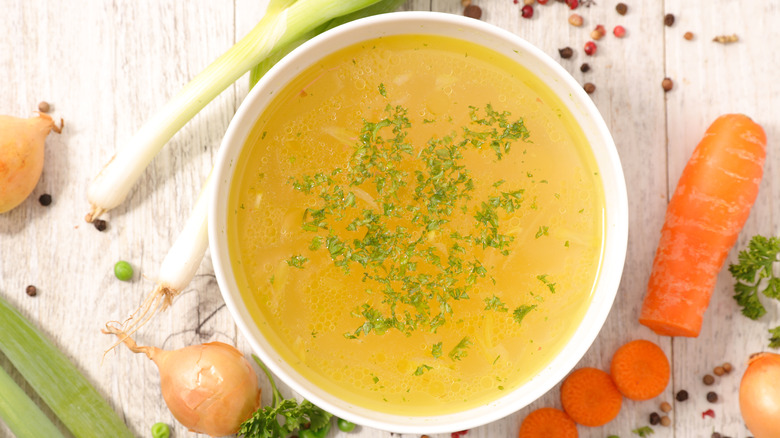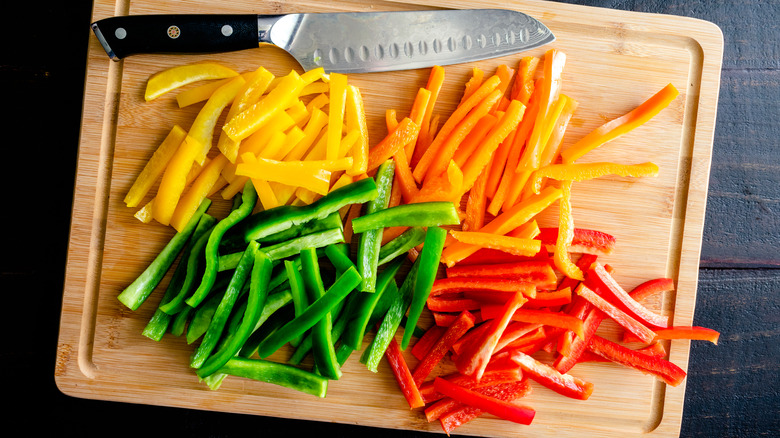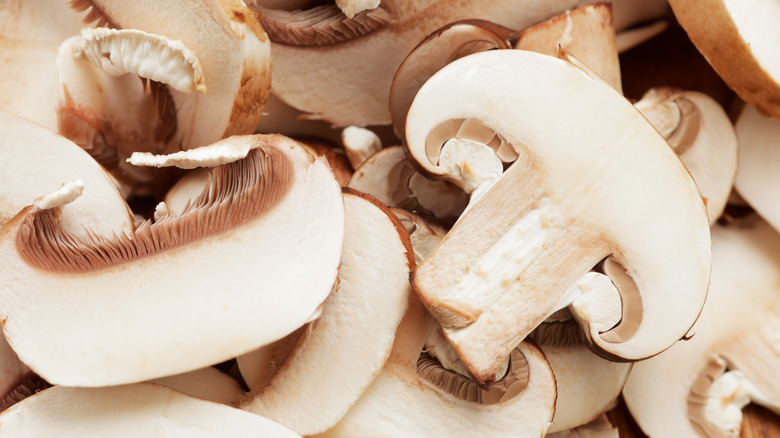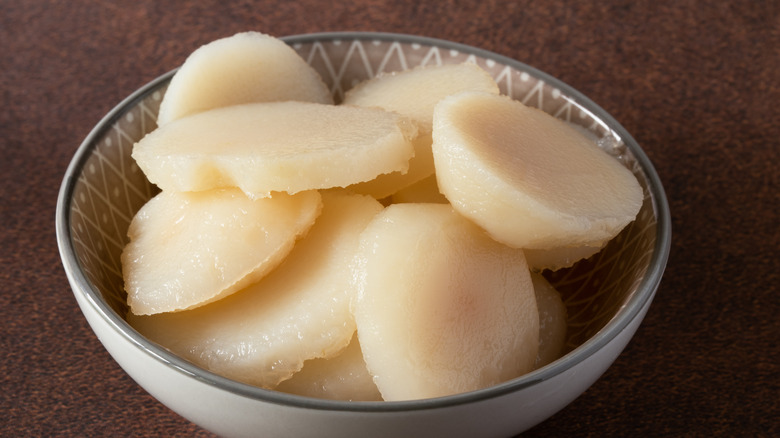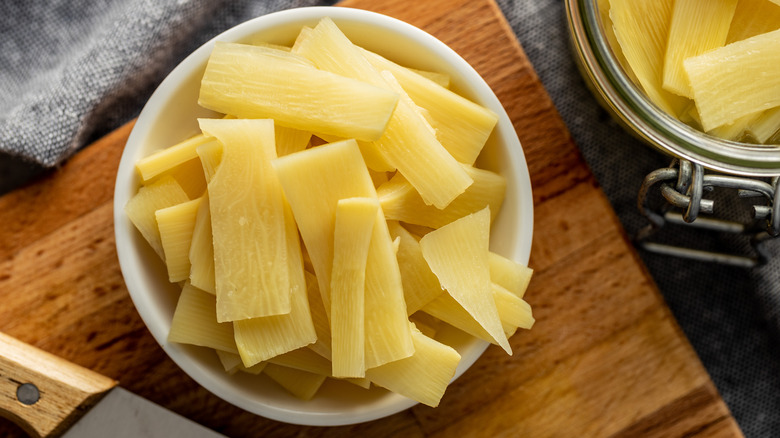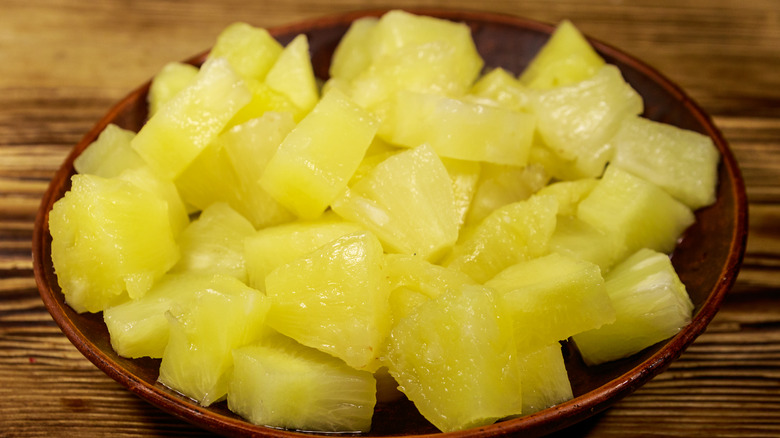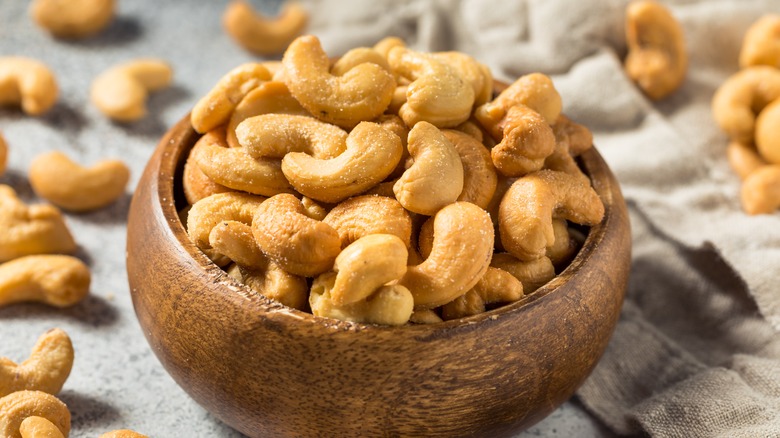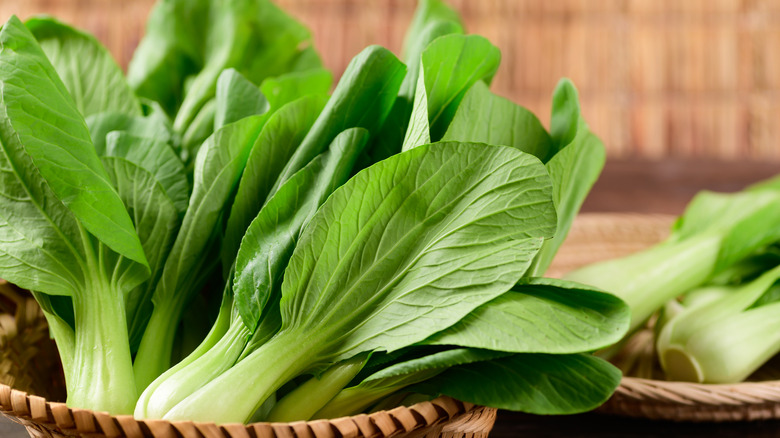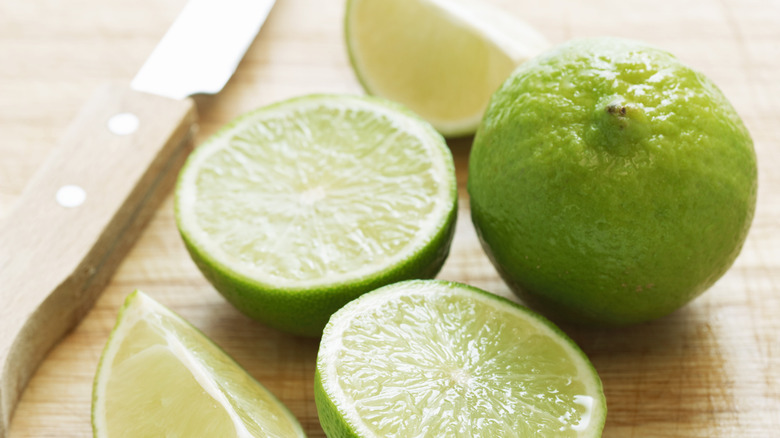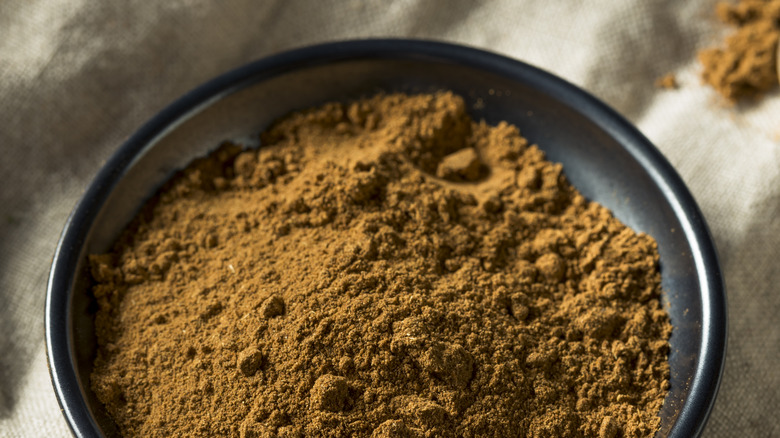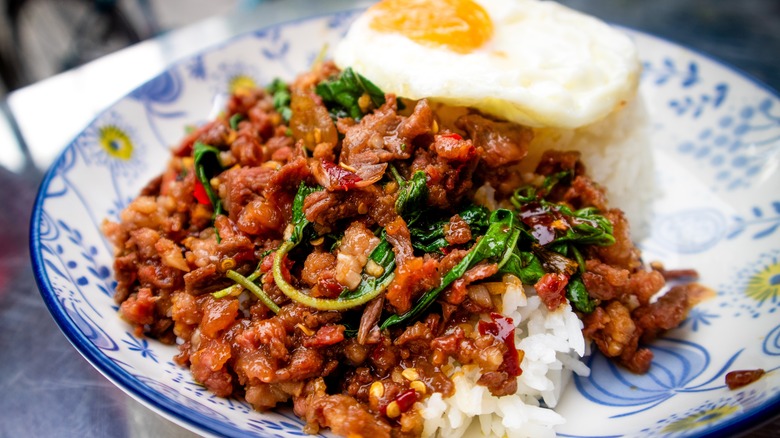15 Ingredients To Spruce Up Frozen Stir-Fry
Frozen stir-fry is a culinary convenience. For starters, they're quick — one bag of frozen stir-fry comes packed with everything you need to make a tasty entree. Usually, there's lots of veggies like broccoli, carrots, and onions, plus protein of some type (depending on the variety you buy), and a savory frozen sauce.
Frozen stir-fries are also easy to prepare, even for the most novice of home cooks. You generally need to add a bit of oil to a hot pan and then sauté everything until it reaches tender, crispy perfection. And best of all, they generally provide a mix of those comforting, umami-packed Chinese food flavors we love, without the hassle or expense of ordering delivery or jumping in the car to grab take out.
But as good as frozen stir-fry is, most packaged food is an ideal candidate for a little DIY sprucing. Add a bit of this or a dash of that and you can customize any of these veggie and protein blends to be even spicier, more savory, most substantial, and even more delicious.
Need some inspiration? Here are 15 of our favorite add-ons and mix-ins, all of which can instantly turn even the blandest and most basic frozen stir-fry into something that tastes like it was made from scratch.
Fresh grated ginger
Fresh ginger is one of the easiest and most impactful ingredients you can add to any stir-fry. It's zesty and slightly spicy flavor profile provides a potent kick to even the most mundane blend of stir-fried veggies.
Although you could use dried ground ginger or even a refrigerated ginger paste in your stir-fry, you get the boldest and most vibrant flavor using freshly grated ginger root.
Step one to incorporating ginger into your stir-fry is of course peeling the ginger — you can do it easily with a spoon. Next, grate or mince some of that peeled ginger so you can add it to your pan. A 1-inch piece of ginger is plenty for a standard-sized stir-fry for two people. (Add more if you really love that unique, spicy, slightly sweet bite!)
For the best-tasting stir-fry, add your ginger toward the beginning of the cooking process. This will allow the root's natural oils to infuse your sauce and will help to make the stir-fry as flavorful as possible. Pair the ginger with a clove or two of fresh minced garlic, another stir-fry staple, for an even more dynamic and authentic pop of flavor.
Hoisin sauce
Every great stir-fry needs a great sauce. And hoisin sauce is one of the best options for adding rich, umami-dense flavor with a hint of sweetness and a touch of saltiness to any stir fry. Made from a mix of soy, salt, sweet potato, sesame seeds, garlic, chili pepper and other spices, hoisin sauce is often considered the Chinese equivalent of ketchup — this thick, dark, and savory sauce tastes good on almost anything!
To add hoisin to your stir-fry, first measure out the amount you'll need. Start with 2 to 3 tablespoons for a stir-fry that serves two to four people. Next, pop your frozen stir-fry bag open, dump the contents into a hot pan, and cook everything according to the package directions. Don't add the sauce too early — it can get watered down as your veggies cook or could also burn depending on how wet your stir-fry dish is as it initially thaws and starts to cook.
Consider hoisin a finishing sauce or condiment and stir it into your wok or pan near the very end of the cooking process, once your veggies are all crisp and caramelized and your protein is hot and ready to serve. The thick tangy sauce should perfectly coat your stir-fry ingredients, giving them an almost glossy appearance plus a depth and complexity of flavor that definitely won't taste like it came from the freezer aisle.
Oyster sauce
Like hoisin sauce, oyster sauce is another ideal (and traditional) Asian staple that's perfect for adding to any frozen stir-fry. As its name suggests, oyster sauce contains a mixture of oyster extract, sugar, water, and salt and is often thickened with corn starch. It's also another widely used condiment and can be integrated as a dressing or dipping sauce for a variety of Chinese, Vietnamese, or Thai appetizers.
In a stir-fry, oyster sauce provides a wonderful blend of robust umami flavor plus a combination of salty, sweet, and slightly earthy notes that will highlight and enhance the taste of all the other ingredients in your stir-fry, from the protein to the veggies, all the way down to the peppers and onions.
As a general rule, start with 1 to 2 tablespoons of oyster sauce for a stir-fry serving two to four people and then add more as needed. As with hoisin sauce, oyster sauce should also be added near the end of the cooking process. Drizzle the sauce into your pan or wok and then toss all your ingredients well, so the sauce is evenly distributed and has time to blend with everything without the risk of burning or becoming watered down.
Sesame oil
Don't make the mistake of lumping sesame oil in with olive oil, canola, or vegetable oil. This is not an oil you cook with. Rather, sesame oil is a finishing oil, designed to bring the rich, nutty taste of toasted sesame seeds — which it is made from — to any dish.
With its potent sesame flavor, sesame oil is an ideal way to amp up and elevate the taste of any frozen, store bought stir-fry. To work it into the dish, first cook your stir-fry according to the directions. Add your oil near the end of the cooking process. This helps to preserve the oil's intense flavor and aroma, preventing it from being overpowered by other ingredients.
Aim for 1 tablespoon of oil per person you are cooking for — add more if needed. To round out your dish, drizzle a bit of soy sauce on your sesame oil-infused stir-fry just before serving. The pairing of sesame oil and soy sauce is a classic, and one that many say can turn any "reasonably willing dish" Asian.
Broths of all types
Most stir-fries, frozen or otherwise, don't require much in the way of added moisture. If anything, they can be too wet and benefit from drying out (and crisping up) as they cook. But if you do ever find yourself needing to add liquid to a frozen stir-fry as it cooks, never pour in plain water. Broth of any type — chicken, beef, or veggie — is a much better, and tastier, option.
Broths not only add a pleasant bit of saltines to your stir-fry, they also help to pack it with layers of additional flavor — with the savory warmness of chicken or beef or the earthy punch of celery or carrots. Use just enough broth to keep your stir-fry from becoming too dry, and add it as needed throughout the cooking process.
If you cook stir-fries often, or like a particularly rich and potent sauce in the frozen stir-fries you do make, you might even consider making your own bone broth to add. It's easy, affordable, and the resulting broth will last in the freezer for months, right next to all your frozen bags of stir-fry.
Sliced bell peppers
Frozen stir-fries typically contain a bit of sliced bell pepper on their own — manufacturers know it adds vital flavor to the dish. But in most cases, they never add enough. So do what they couldn't and throw in as much fresh bell pepper as you'd like to your pot or wok as your stir-fry cooks. With their crisp, juicy texture and mildly sweet and slightly tangy flavor, bell peppers bring a burst of color and freshness to meaty steak stir-fries, lean and low cal chicken stir-fry, and even hearty and savory plant-based stir-fries.
For the best-tasting dish, use a variety of different colored bell peppers — each has a slightly unique and wonderful taste all their own. Clean them well, remove the core in the middle with all the seeds and then slice them into long, thin wedges. Add your sliced bell peppers early in the cooking process, right when you start sautéing your other ingredients. This allows them plenty of time to soften slightly while still retaining their crispness and vibrant color.
Sliced mushrooms
As with bell peppers, many frozen stir-fries include sliced mushrooms as part of their pre-made veggie blend. But again, there's often not enough mushroom there — and stir-fry is really all about that savory umami kick, so it makes perfect sense to add more mushrooms to your dish.
But don't limit yourself to white or button mushrooms, which is typically what frozen stir-fry mixes provide. Instead, consider picking up a box of shiitakes or cremini (aka "baby bella") mushrooms. Portobellos, oyster mushrooms, enoki, maitake, and lion's mane are also all wonderful options and will all work beautifully in any stir-fry.
Rinse your mushrooms well, just before use, and then slice or dice the fungi into bite-sized pieces. Next, sauté the mushrooms by themselves before you cook the rest of your stir-fry. This step is very important, since mushrooms are loaded with water and can make a stir-fry overly wet. Cook until soft and slightly caramelized and then remove from the pot and set aside. Cook the rest of your stir-fry as normal — right before serving, put your mushrooms back in the wok and cook everything for one to two minutes or until the mushrooms are once again warm and ready to eat.
Water chestnut slices
With their super sweet flavor, and crisp, crunchy texture, water chestnuts are a bit like an apple or tiny potato that grows underwater in a pond. Some describe their flavor as a cross between coconut and a pear.
A renowned addition to homemade and restaurant prepared stir-fries, water chestnuts aren't often part of the mix you find within a frozen stir-fry bag. Which is all the more reason to add them to the dish yourself.
Although you can sometimes find water chestnuts for sale fresh in large specialty markets, the easiest way to get them is by the can. Because of this, working them into your stir-fry couldn't be easier. Just pop open the can, strain and rinse the sliced water chestnuts inside, and then dump them into your wok when your stir-fry is in the later stages of cooking, just before serving. This ensures they maintain their delightful crunch and don't become overly soft as a result of overcooking.
Bamboo shoots
Like water chestnuts, bamboo shoots are another stir-fry essential that's often lacking when you buy the Asian dish pre-frozen in a bag. These thin, yellow edible shoots are the tender, young sprouts that emerge from the ground as a bamboo plant grows and spreads. Farmers harvest them when young to ensure maximum tenderness and the mildest flavor possible — hints of nut with a slightly sweet, natural woody and vegetal quality.
While you can sometimes find bamboo fresh in large stores, the easiest way to get them is again by the can. And the technique for adding them to your stir-fry is also very similar. Open the can and drain and rinse the shoots inside. Depending on their size, you may want to dice them into smaller, more bite-sized pieces. Add your bamboo shoots to your stir-fry just before it finishes cooking, so the canned shoots stay as crisp and crunchy as possible when you serve them.
Pineapple chunks
Pineapple on pizza can be controversial — not everyone agrees it should be there. And the same can be said for stir-fry. Some people insist that stir-fries are meant to be rich and savory. But if you're the type that likes the tropical, sugary tartness pineapple provides, adding some fresh or canned pineapple tidbits to your frozen stir-fry can be a great way to amp up the dish and make it your own.
In most cases, it's good to start with about 1/2 cup of drained pineapple for every two people you are serving. Of course, add more if you like things really fruity. Then, to keep your pineapple from falling apart, be sure to add it to your stir-fry in the very last few moments of the cooking process. You basically want to fold it into the dish and let it cook until warm, stirring as minimally as possible so your pineapple maintains its shape until it's served. To further complement that sweetness, consider adding a touch of chili sauce or crushed red pepper flakes to your stir-fry as well. Both provide a spicy kick that plays beautifully against pineapple's inherent sweetness.
Cashews (or peanuts)
From cashew chicken to Kung Pao beef topped with peanuts, nuts of all types play an integral role in a variety of classic Chinese dishes. So if you're making stir-fry and want to make it better, adding cashews (or peanuts) is another tasty option. In addition to that wonderful earthy flavor, nuts provide texture and crunch and a bit of butteriness to your stir-fry — and working them into the dish couldn't be easier.
Start with between 1/2 cup and 1 cup of the unsalted nuts of your choice. Next, toast the nuts gently in a dry skillet over medium heat until fragrant and golden brown. Be careful not to cook them too long; nuts can burn quickly if you aren't paying close attention. Once roasted, remove the nuts from the pot and set aside. Cook your stir-fry as normal and then right before serving, once you've added all your proteins and sauces and other ingredients to your stir-fry, dump the nuts in and mix everything together one last time.
Cashews and peanuts both become soft when exposed to too much heat, so adding them to your stir-fry just before serving is the best way to help preserve their delightful crunch and nutty richness.
Baby bok choy
When it comes to adding flavor and crunch to frozen stir-fries, baby bok choy is a game changer. These tender and vibrant Asian greens are a member of the cabbage family and are a true culinary powerhouse, offering a mild, slightly peppery taste with a hint of sweetness that pairs wonderfully with all variety of stir-fry sauces and ingredients.
Baby bok choy in particular — leaves from a younger plant that has yet to fully mature — can add a crisp texture and pleasing crunch to stir-fries that's often missing when you eat the mix alone or as it was originally packaged. While you can add as little or as much bok choy to your stir-fry as you like, start with 1 or 2 bundles of the leaves per serving and then work up as needed.
To add baby bok choy to your stir-fry, first rinse it thoroughly under cold water to remove any hidden dirt or debris from between the leaves. Then, trim the ends and separate the stalks from the leaves. You can either leave the stalks whole or slice them into bite-sized pieces. Next, as you cook, add the stalks to your stir-fry early in the process since they take a bit longer to soften. Once they become tender and the rest of your stir-fry is almost complete, add the bok choy leaves. Let them cook briefly. Once they begin to wilt, your dish is ready to serve.
Fresh lime juice
From margaritas to ceviche to homemade guacamole and fresh garden salads, fresh lime juice makes everything it touches taste better. And that includes frozen stir-fries! Lime juice is ideal for adding zest and freshness — along with acid — to foods. It brings out subtle hidden flavors you might not otherwise notice and enhances the natural flavors that food already possesses. It also has a remarkable ability to cut through the richness of sauces and oils, imparting a zesty kick that truly awakens the taste buds with its invigorating tartness.
To work lime juice into a stir-fry, you have a couple options. Either cut a whole lime in half and then squeeze half into the stir-fry just before serving, adding the other half as needed if you want more zing. Or, slice your lime into individual wedges and put a couple on each plate as a garnish when you serve your stir-fry. This way, each diner can squeeze on as much of the tangy elixir as they like.
Five-spice powder
No extra veggies on hand? Not into extra sauces, but still looking for a way to give your frozen stir-fry a "glow up" and turn it from good to great? No worries! One of the easiest and most effective ways to add flavor and punch to any stir-fry is with the addition of a bit of magic powder known as Chinese Five-spice.
Made from a mixture of star anise, cloves, Chinese cinnamon (or cassia), Sichuan pepper, and fennel seeds, Five-spice is the perfect addition to stir fry because it contains so many different flavors. It imparts a complex blend of sweet, savory, and slightly spicy to your stir-fry, all at the same time. Just be forewarned: It's potent! A little goes a long way, so start with 1/2 teaspoon for a stir-fry serving two, and then add more as needed. You can add the spice anytime during the cooking process. However, if you toast it in your dry pot for a minute or two before you toss in other ingredients, you may find it's even more flavorful and delicious.
If you don't have Five-spice, you can also use other similar spice blends like allspice, Garam Masala, or even pumpkin pie spice (which contains cinnamon, cloves, nutmeg, and allspice and can be used in savory dishes) to add similar warmth and depth to that frozen stir-fry.
More protein
Finally, the last and perhaps most essential way to bolster the quality of any frozen stir-fry is by simply packing even more protein into the dish. If you buy frozen chicken or beef stir-fry, the amount of meat included within your bag may sometimes seem a bit skimpy. That's why we recommend adding as much additional protein to that dish as you can possibly stuff into your wok.
You might consider adding strips of chicken or roast turkey. Or perhaps chunks of a favorite lean steak. You could add ground beef or pork, sausage, ham, Spam, or even shrimp — the options are endless. The one thing to keep in mind is that your meat should be fully cooked before you add it to the pot. It could be leftovers from the day before, it could be from the freezer, or you could sauté it before you make the rest of your stir-fry.
Whatever the case, have your cooked meat ready to go then stir-fry your vegetables until they are almost done. In the final stages of cooking, add your protein and any other sauces to the pot with those veggies. Toss everything until it's mixed well, and continue cooking until all your ingredients are warm and have had a couple minutes to meld together into one cohesive, complete dish. Finally, top with any garnishes you'd like — a bit of fresh cilantro or basil or a dash of sesame seeds — and dig in. Enjoy!


